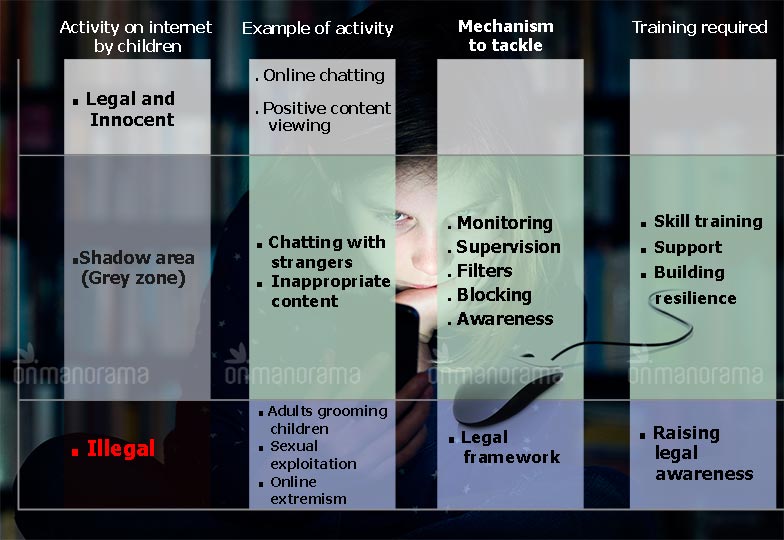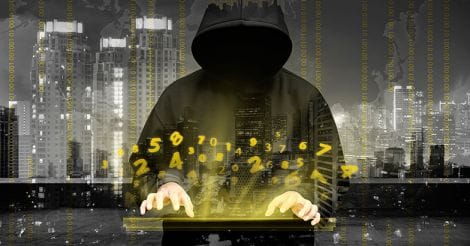(K Sanjay Kumar Gurudin, an IPS officer of the 2005 batch, Kerala cadre, is a socially conscious cop, a well-known cyber expert, and an author of the must-read book 'Is Your Child Safe?' He has had an outstanding and illustrious career as superintendent of police in Kerala).
There is no doubting the fact that the Internet yields numerous opportunities and benefits for children in terms of its impact on their educational attainment. However, it has also exposed children to very serious dangers (modern-age crimes), that defy age, geography and other boundaries, unlike in the real world.
Social networking sites have made things so easy for predators to target their victims online. Children are being groomed or lured into sexual conversation or exploitation by adult offenders, or being bullied or harassed online.
This has also caused abusive images of children getting shared on the Internet. It is a bitter truth that cyber offenses against children are increasing, as new and creative ways are identified and employed to harass, abuse and exploit them. The problem is not limited to India, but is a challenge globally.
Although cases are being reported to the police, these are only the proverbial tip of the iceberg! It is believed that such offenses are much higher than what statistics show.
It is creating a tremendous impact on the personal lives of teenagers, who are highly vulnerable to such offenses, resulting in emotional instability, depression and leading to even suicides.
Moreover, some online crimes are being committed by the teenagers themselves, without realizing the repercussions. Such teenagers are more often than not totally ignorant of the gravity of their crime.
In both the situations, it is our prime responsibility to protect children from becoming the victims or the perpetrators.
Unfortunately, the risks of online abuse and exploitation of children have received much less attention in the legal framework and among policy makers. Online abuse is not even included in the statistics as a separate category.
The mechanism to protect children from online abuse and respond effectively to the dissemination and consumption of online child sexual abuse materials falls far short of existing needs.
In addition, being able to stay anonymous online and impersonate others have emboldened people into offensive and criminal acts and has lowered the deterrent potential of laws.
Why legal framework is not sufficient

The chart broadly distinguishes three types of online activity of children.
(A) Innocent and positive activity, which does not require any action.
(B) Grey area, maximum online activity of children comes under this category, which can be considered harmful and abusive online behavior but does not constitute a criminal offense and cannot be criminalized.
(C) Illegal, online sexual exploitation of children, small area for which legal framework exists, but requires robust action, particularly from law enforcement agencies.
For the 'Grey Area,' there is a need to embed efforts to protect children in a wider digital citizenship approach. There should be widespread awareness among parents, teachers, the police and policymakers of the growing and ever-changing risks of child online abuse and exploitation.
But as parents, are we going to wait till all stakeholders come on a platform and systematically work together to handle this menace?
That shouldn’t be the case as, ultimately, it is a serious matter concerning the safety and security of our children.
The responsibility to inculcate a culture of disciplined online behavior among children, to prevent them from becoming victims, lies foremost with the parents. It is hence highly important that parents themselves have an understanding of the latest dangers associated with the internet, new forms of harassment, exploitation and the remedial measures.
Give a thought
White collar crimes, economic offences and frauds come to the mind when we talk about cybercrimes. Till 2008, even our-law makers thought this way.
Spammers. Hackers. Identity thieves. These are not words that elicit the level of concern and emotion that bullying, sexting, or online predators do when kids are involved.

But as someone who has worked in the police department for over a decade and with the lens of a parent and as an advocate of Internet safety, I can tell you that your kids (and you) are more likely to encounter the work of cybercriminals than possibly any of the other risks we talk about in the real world.
Cybercriminals set up their elaborate snares to attract young people. Social networks, mobile app stores, popular websites, gaming downloads, and even texts – the places where young people spend most of their time online – are not entirely cybercrime-free. Legal framework is by and large fairly enabling and can be invoked to address several cyber offences against children.
But in various cyber threats of cyberbullying, cyberstalking and sexual abuse involving grooming, sexting and child pornography our laws are not sufficient.
Many acts such as sexting and cyberbullying that have been criminalized in other countries are not, as yet, considered offences under Indian law.
Hence, it becomes utmost essential to take precautions and safety measures to safeguard our kids. It is the responsibility of parent to ensure that children’s dignity, security and privacy on the Internet are strengthened, and they are familiarized with, and skilled in keeping themselves safe in his technology era.
If you bungle raising your children, I do not think whatever else you do matters very much.
(Please direct your queries to korisanjay7ips@gmail.com)
Read more: Straight Talk | What drives CPI to take its bigger ally heads on

























 Social networking sites have made things so easy for predators to target their victims online. Photo: iStock
Social networking sites have made things so easy for predators to target their victims online. Photo: iStock